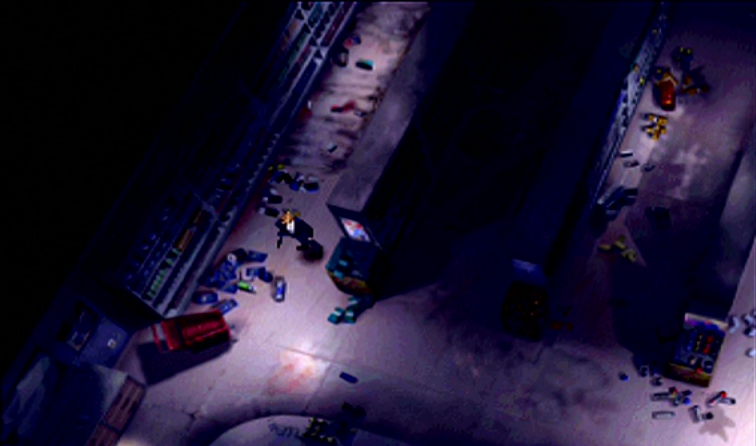I was introduced to the wide world of video games through my dad with a PlayStation console and Crash Bandicoot. These were the foundations upon which I began my lifelong journey as a gaming aficionado, but I’d be remiss to not mention the “Interactive CD Sampler Pack: Volume 8" disc I owned, which introduced me to my favorite 3D platformer series: the Spyro the Dragon trilogy. Other demos were featured that I played several times over, such as portions of Medieval and Metal Gear Solid. However, I distinctly remember a cinematic trailer for a horror game that showcased some of the most disturbing creatures I could’ve imagined when I was five years old, and with an M rating, playing it was out of the question. That was nearly two decades ago, so it's high time I crack the case on whether Parasite Eve is as horrifying and exhilarating as it appeared to be all those years ago.

In light of the game’s numerous comparisons to Resident Evil, they're certainly apt. The story follows police officer Aya Brea In the Big Apple. She's out to see a Broadway show, but it turns to chaos when the theater’s attendees begin erupting in flames. One of the actresses is behind the madness, and Aya decides to pursue the strange woman backstage. Rambling on about the uprising of Mitochondria and how she should know her, this “Eve” escapes after transforming into a grotesque monster. The rookie cop knows what she has to do. Embarking on a mission to avenge the fallen, Aya will slowly uncover secrets of a biological conspiracy and family history that could shape humanity’s fate.
Abandoned buildings crawling with mutated animals and humans, outlandish biological threats with complicated exposition—it’s aspects like these that make Parasite Eve akin to the famous survival horror franchise in terms of its premise and setting. It’s comparably cheesy with its writing and silly with how everything plays out, but it does have an edge with character relationships and moderately compelling mysteries. It does take itself a bit too seriously though, as evidenced by the shocking amount of dialogue sequences that seemingly take up half of the game. Even still, the effort expended into the story with some of its complex plot threads is admirable, which is more than enough to motivate you to see Aya’s journey through.

The prerendered environments and camera setup also evoke Resident Evil, and it’s safe to say Parasite Eve is comparably impressive, if not more so, with massive backdrops of the cityscape and rooms packed with intricacy, such as miscellaneous detritus scattered across floors, reflecting mirrors, moody lighting, and so forth. It's nice that you get a full tour of New York City as well, going from a snow-laden Central Park to the storied, massive American Museum of Natural History. Some detours are shockingly linear and leave more to be desired, but others thankfully turn into sprawling adventures as you let instinct guide your way. In regard to the cinematic cutscenes, they truly are a technical achievement for 1998, providing beautiful fly-byes of the city at night or a disgustingly detailed transformation scene of an animal morphing into the unthinkable.
There’s promising depth to the gameplay at the onset. Aya can equip weapons and armor, supplemented not only by restorative and stat-altering items, but also “PE” (Parasite Energy) that allows her to boost herself or impair enemies in various ways. Over the game’s course, there’s much to choose from should you explore your surroundings, and it’s neat how you can even transfer stats and effects (increased rate of fire, elemental attributes, etc.) from obsolete weapons and equipment. Being half of an RPG, it’s no wonder that the leveling systems, customization, and inventory management are advanced. It’s unfortunate then that turn-based battles become repetitive in execution.

A recent example of this type of gameplay is found in Transistor. With a host of moves and secondary effects to play with, combat never grows stale because changing out and altering Functions vastly alters how you approach each battle. No one ability feels the same or is better than another, so experimentation is encouraged. Should you take the same approach with Parasite Eve, you’ll find that it boils down to shooting, running around, and repeat. Besides remaining close to enemies for the most effective damage, strategic positioning is hardly encouraged. Since all weapons are functionally the same and largely share from the same pool of ammo, taking a turn to switch to another one is rarely useful. Special abilities involving PE , such as slowing down or confusing enemies, don't afford many advantages. What this means is that despite a plethora of weapons, armor, and mechanics, they only provide the illusion of depth. For example, even though there’s an excellent variety of foes, their weaknesses and strengths mean little, so there's no point in approaching any of them differently. And since supplies come in gross quantities, you rarely feel any tension or “horror” in this horror game. It’s a shame since a solid framework is here that works well enough, but it doesn’t go far enough to stimulate much challenge or excitement.
Some of the winding, massive buildings are fun to explore as you piece together the environment from scratch (there are no maps to reference), so you would think a sense of foreboding or depth to your surroundings would result from this. Besides randomized battles à la wild Pokémon encounters and chests to open, there’s little personality to the actual level design. It makes the game feel too straightforward and linear in the goals it sets before you, even though there are some moments that pop up where good backtracking and layered steps to move forward become evident.

It should be said that the audio department is well rounded. While there’s strangely no voice acting for such a dialogue-heavy story or ambient noise for settings that need it, Yoko Shimomura’s score saves the day. Altogether, it’s like an electronic opera, and strong melodies and a reliance on the piano confirm that the legendary composer is the mastermind behind it. After you’ve been humming to the battle theme for some time, you’ll find the experience rounds up to eight to 10 hours in length if you go at a leisurely pace.
Considering the gameplay’s lacking luster, I'm glad it wasn't any longer since it shows all it has to offer halfway through. But can the title's peripheral elements make up for its primary missteps? It's safe to say that Parasite Eve holds its own with crazy yet intriguing plot threads and detailed environments. The ambitious score also makes up for the lack of ambient noise and voice acting, and there's much to be admired with what the game design sets out to do. However, it doesn't pan out to promote cautioned, strategic approaches, which drains the game's long-term vitality.
This game was purchased by the reviewer and reviewed on the PlayStation 3. Parasite Eve was reviewed to fulfill the generous pledge we received from Dayis for our Kickstarter campaign.
Review Summary
Parasite Eve possesses lasting vigor with an infectious score, meticulous graphics, and character-driven story that will hold your attention. Its RPG mechanics and combat are equally impressive in scope, which are fun to learn at first, but the actual action falls ill since mastering its nuances proves pointless with mediocre design backing it up.
(Review Policy)Pros
- Yoko Shimomura’s Soundtrack
- Loads of Equipment and Weapons To Toy With
- Solid Cast of Characters
- Freaky Good Enemy Design
- Prerendered Settings and Great Cutscenes
Cons
- Ignorable RPG Systems and Mechanics
- Repetitious Gameplay
- Lacking Level Design
- No Voice Acting
- Odd Dialogue and Exposition
Have a tip, or want to point out something we missed? Leave a Comment or e-mail us at tips@techraptor.net











